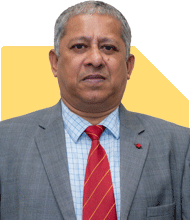Ramalingam Kalirajan |7720 Answers |Ask -Follow
Mutual Funds, Financial Planning Expert - Answered on Jun 07, 2024
He has an MBA in finance from the University of Madras and is a certified financial planner.
He is the director and chief financial planner at Holistic Investment, a Chennai-based firm that offers financial planning and wealth management advice.... more

Hi sir I am now 35 and I am planning to retire at 50 I have many debts in hand like home loan of 13 lakh and personal loans ranging about 6 lacs. Firstly how to properly close off the debts with a cumulative monthly income of 65k and then plan for a monthly income of 50 km month after 50
Thank you for your query. At 35, you have ample time to address your debts and plan for a comfortable retirement at 50. Your goal of achieving a monthly income of Rs.50,000 post-retirement is achievable with a strategic approach. I commend your proactive thinking and commitment to securing your financial future.
Understanding Your Current Financial Situation
Before moving forward, let's analyze your current financial position, including your income, expenses, and debts.
Monthly Income and Expenses
Your cumulative monthly income is Rs.65,000. It's crucial to break down your monthly expenses, including essentials, discretionary spending, and debt repayments.
Existing Debts
You have a home loan of Rs.13 lakh and personal loans totaling Rs.6 lakh. Managing and reducing these debts is essential for your financial health.
Creating a Debt Repayment Strategy
Clearing your debts should be your first priority. A structured approach will help you manage your finances better.
Prioritize Your Debts
List your debts in order of interest rates. Typically, personal loans have higher interest rates than home loans. Paying off high-interest debts first saves money in the long run.
Budget Allocation
Allocate a specific portion of your monthly income to debt repayment. Ensure you cover minimum payments on all debts to avoid penalties.
Debt Snowball vs. Debt Avalanche
Consider the debt snowball method (paying smallest debts first) or debt avalanche method (paying highest interest debts first). Choose the one that motivates you more.
Extra Payments
Whenever possible, make extra payments towards your loans. This reduces the principal amount and interest paid over time.
Budgeting and Expense Management
Effective budgeting is crucial for debt repayment and saving for retirement.
Track Your Expenses
Keep a record of your daily, weekly, and monthly expenses. This helps identify areas where you can cut back.
Reduce Unnecessary Spending
Identify non-essential expenses and reduce them. This frees up more money for debt repayment and savings.
Emergency Fund
Maintain an emergency fund covering 3-6 months of expenses. This prevents you from taking on additional debt in case of unexpected expenses.
Saving and Investing for Retirement
Once your debts are under control, focus on saving and investing for retirement. Here’s a step-by-step approach to help you achieve your goal of Rs.50,000 monthly income post-retirement.
Define Your Retirement Corpus
Calculate the corpus needed to generate Rs.50,000 monthly post-retirement. Assuming a 4% withdrawal rate, the required corpus can be calculated as:
Rs.50,000×12/0.04=Rs.1,50,00,000
Systematic Investment Plan (SIP)
Invest regularly through SIPs in mutual funds. This helps in building a substantial corpus over time.
Diversify Your Investments
Diversify your investments across equity, debt, and hybrid mutual funds. This balances risk and returns.
Equity Mutual Funds
Equity mutual funds offer higher returns but come with higher risk. Suitable for long-term goals like retirement.
Debt Mutual Funds
Debt mutual funds provide stable returns with lower risk. Ideal for conservative investors.
Hybrid Mutual Funds
Hybrid mutual funds invest in a mix of equity and debt, balancing risk and reward. Suitable for moderate risk-takers.
Calculating Future Value of Investments
Let's assume you start investing Rs.20,000 per month in mutual funds with an average annual return of 12%.
FV = 20,000 × 576.35
FV = Rs.1,15,27,000
By investing Rs.20,000 monthly, you can build a substantial corpus by the age of 50. This corpus will help you achieve your retirement goal.
Monitoring and Adjusting Your Plan
Regularly review your financial plan to ensure you are on track. Adjust your investments based on market conditions and personal circumstances.
Regular Reviews
Conduct annual reviews of your financial plan. Assess your progress and make necessary adjustments.
Rebalancing Your Portfolio
Rebalance your investment portfolio periodically. This ensures your asset allocation remains aligned with your risk tolerance and goals.
Staying Informed
Stay informed about financial markets and investment options. This helps you make informed decisions.
Final Insights
Achieving financial independence requires careful planning and disciplined execution. Focus on clearing your debts first. Then, save and invest wisely for your retirement. By following a structured approach, you can retire comfortably at 50 with a stable monthly income.
Best Regards,
K. Ramalingam, MBA, CFP
Chief Financial Planner,
www.holisticinvestment.in
You may like to see similar questions and answers below
Ramalingam Kalirajan |7720 Answers |Ask -Follow
Mutual Funds, Financial Planning Expert - Answered on Jun 17, 2024
Ramalingam Kalirajan |7720 Answers |Ask -Follow
Mutual Funds, Financial Planning Expert - Answered on Jul 25, 2024
Ramalingam Kalirajan |7720 Answers |Ask -Follow
Mutual Funds, Financial Planning Expert - Answered on Oct 18, 2024
Ramalingam Kalirajan |7720 Answers |Ask -Follow
Mutual Funds, Financial Planning Expert - Answered on Dec 27, 2024
Prof Suvasish Mukhopadhyay |340 Answers |Ask -Follow
Career Counsellor - Answered on Jan 30, 2025
Prof Suvasish Mukhopadhyay |340 Answers |Ask -Follow
Career Counsellor - Answered on Jan 30, 2025
Prof Suvasish Mukhopadhyay |340 Answers |Ask -Follow
Career Counsellor - Answered on Jan 30, 2025
Shalini Singh |144 Answers |Ask -Follow
Dating Coach - Answered on Jan 30, 2025
Prof Suvasish Mukhopadhyay |340 Answers |Ask -Follow
Career Counsellor - Answered on Jan 30, 2025
Prof Suvasish Mukhopadhyay |340 Answers |Ask -Follow
Career Counsellor - Answered on Jan 30, 2025
Shalini Singh |144 Answers |Ask -Follow
Dating Coach - Answered on Jan 30, 2025
Prof Suvasish Mukhopadhyay |340 Answers |Ask -Follow
Career Counsellor - Answered on Jan 30, 2025
Prof Suvasish Mukhopadhyay |340 Answers |Ask -Follow
Career Counsellor - Answered on Jan 30, 2025
Ravi Mittal |516 Answers |Ask -Follow
Dating, Relationships Expert - Answered on Jan 30, 2025
























